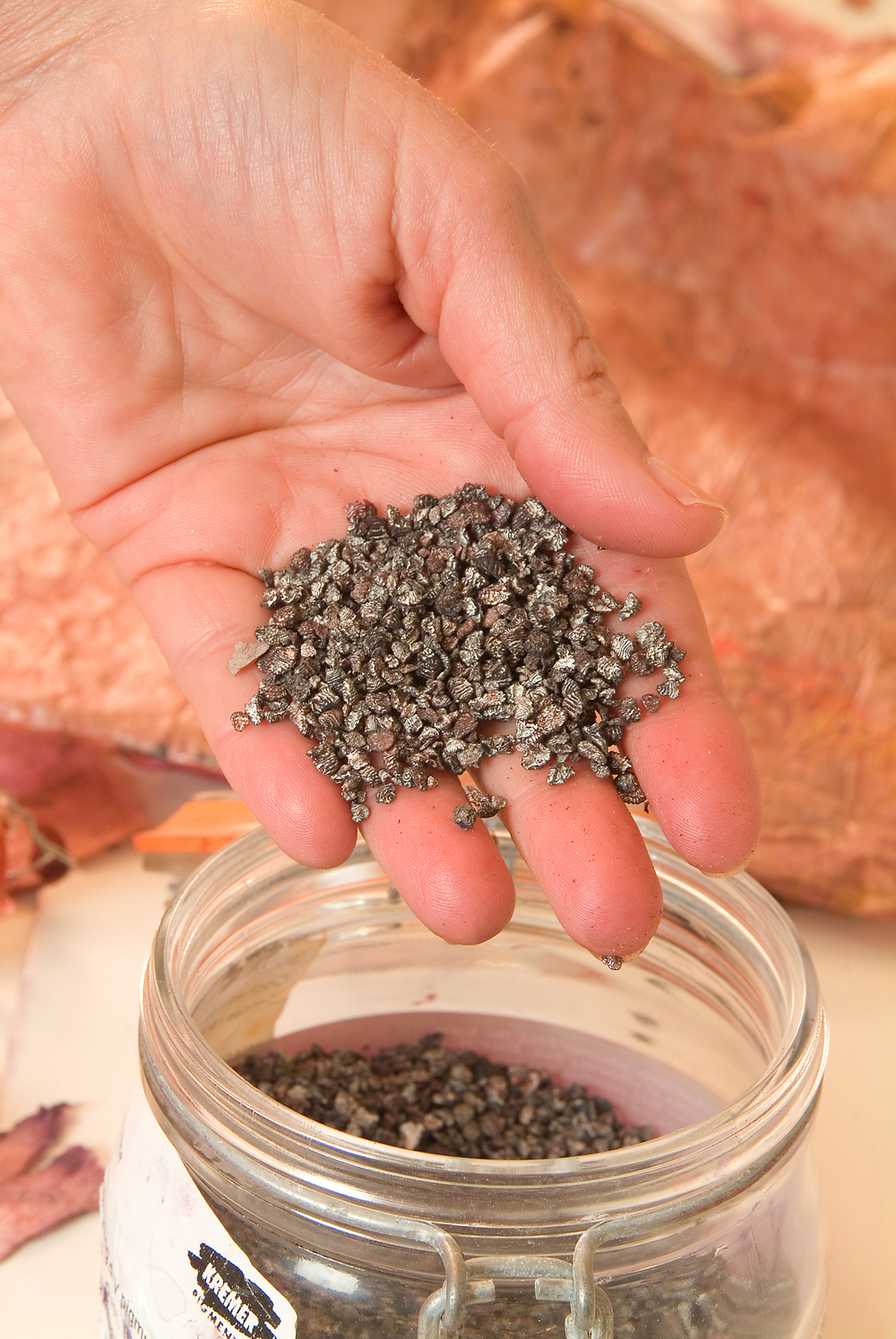No matter how determined I was to make organic dyes, I found that it was easier said than done. My studio had to be completely transformed into essentially a chemical lab where mordants would be carefully measured, and used to make the dyes. Tables replaced easels. Tubes of oil-based paints were exchanged for flowers and vegetables. Plastic containers were used instead of palettes. Media were exchanged for distilled water. Paper took the place of canvas rolls. Photographic trays became the vats where the papers were dyed. Electric burners, stainless steel pots, PH kits for testing water, measuring spoons, and coffee grinders became indispensable components of the lab. I had no idea what some of these pieces of equipment were, or how they were to be used. I felt completely lost. I needed HELP! That help came from friends, librarians, the Internet, product catalogs, and lots of books. Of the many books that I read, three of them proved to be invaluable- “Natural Dyes & Home Dyeing” by Rita J Adrosko published in 1971 by Dover publications, “ Color ”by Victoria Finlay published in 2004 by Random House Trade Paperbacks, and “ A Perfect Red” by Amy Butler Greenfield published in 2005 by Harper Collins Publishers. The last of these books fascinated me. It instilled in me a passion about this minuscule female insect that when dried and ground gives an intense brilliant red. It played an important role in the pre-hispanic era, and in Europe, where for three centuries it was the most coveted red dye highly sought by royalty and religious clerics. The cochineal continues to be used extensively as a natural dyeing agent. It was the intense brilliant RED DYE of cochineal and its amazing history that inspired me to delve further into pre-hispanic culture.
Top Left , Photographic Trays , Bandejas Fotograficas. Photo by Yarrington Studio
Bottom Left , Intense Brilliant Red, Rojo Intenso y Brillante . Photo by Elena Osterwalder
No importaba cuanto deseaba yo hacercolores orgánicos, como todo en esta vida: es mas fácil decirlo que hacerlo. Mi taller se convirtió de la noche a la mañana en un laboratorio químico donde los mordantes se miden con exacta precisión , para hacer los tintes. Mesas reemplazan a los caballetes. Flores y vegetales sustituyen a las pinturas de oleo. Cubetas plásticas se usan en lugar de las paletas. Solventes tóxicos se cambiaron por agua destilada. Papel tomó el lugar de los lienzos. Bandejas fotográficas se convirtieron en los Vats donde se tiñe el papel. Hornillas eléctricas, cacerolas de acero inoxidable, kits para medir el PH del agua , cucharas medidoras, y molinillos de café se hicieron indispensables. Yo no tenia la menor idea de que eran ni como se iban a utilizar varias de estas cosas. Estaba completamente perdida . Necesitaba AYUDA! La ayuda vino de mis amigos , de bibliotecarias, del internet , de catálogos y de los muchos libros que leí. De estos libros, tres fueron invaluables. “ Natural Dyes & Home Dyeing” de Rita J Adrosko publicadoen 1971 por Dover Publications, “ Color” de Victoria Finlaypublicado en 2004 por Randon House Trade Paperbacks, y “APerfect Red “ de Amy Butler Greenfield publicado en 2005 por Harper Collins Publishers. El ultimo es estos libros me fascinó y me inculcó una pasión por este insecto minúsculocuya hembra al secarla y molerla da un rojo intenso y brillante. Jugó un papel importante en el periodo pre-hispánico y en Europa donde por tres siglos era el tinte rojo mas codiciado por la realeza y el clero . La cochinilla sigue usándose como un tinte natural en los cosméticos y en la comida. Fue el TINTE ROJO de la cochinilla y su historia increíble que me inspiro a ahondarme en la cultura prehispánica.
Plastic Containers , Cubetas Plastics Photo by Yarrington Studio.




